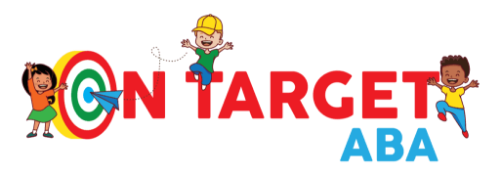🧠 AI Summary:
This blog helps parents understand how ABA therapy views and addresses challenging behaviors in children with autism. It explains what triggers meltdowns, how therapists assess and replace behaviors with positive alternatives, and how progress is measured over time. Using relatable examples and the supportive approach of On Target ABA, readers will see how compassion, data, and consistency transform everyday struggles into measurable milestones.
💙 Introduction: Every Behavior Has a Story
Every smile, word, or meltdown tells a story. For children with autism, behavior is often their most powerful way to communicate — especially when language or emotional regulation is still developing.
At On Target ABA, we know that challenging behaviors aren’t “bad.” They’re messages waiting to be understood. Our job as therapists, and as parents, is to listen to what those messages mean — and to teach children safer, more effective ways to express themselves.
Understanding behavior through the lens of Applied Behavior Analysis (ABA) transforms frustration into opportunity — and meltdowns into milestones.
🧠 What ABA Therapy Teaches About Behavior
ABA therapy is grounded in one powerful idea: all behavior serves a purpose.
When a child screams, avoids a task, or seeks sensory input, there’s always a reason — a need they’re trying to meet. ABA helps identify why the behavior happens so we can teach healthier ways to meet that same need.
The process looks like this:
- Identify the behavior. (What are we seeing?)
- Understand the function. (Why is it happening?)
- Create a plan. (What can replace it?)
- Reinforce success. (How do we make the new behavior stick?)
This method allows therapy to be proactive, not reactive — focusing on skill building, not punishment.
🧩 Common Functions of Behavior
ABA professionals classify behaviors by their function — the “why” behind the action.
1. Escape or Avoidance
A child may act out to avoid a difficult or unpleasant task (e.g., covering their ears when a vacuum runs).
2. Attention
Some behaviors occur to gain a parent’s or peer’s attention (“Look at me!” even if it’s through yelling).
3. Access to Tangibles
Crying or grabbing may occur when a child wants a favorite toy or snack.
4. Sensory or Automatic
Certain actions, like hand-flapping or rocking, meet internal sensory needs.
Understanding which of these applies allows therapists to tailor interventions that truly work — replacing frustration with communication and structure.
💬 Why Meltdowns Happen
A meltdown is not a tantrum; it’s an overwhelming response when a child’s sensory or emotional system is overloaded. Common triggers include:
- Sudden changes in routine
- Loud or bright environments
- Demands that feel too hard
- Fatigue, hunger, or illness
- Difficulty communicating wants or feelings
At On Target ABA, we see meltdowns as signals that something needs adjusting — the environment, the task, or the support. With patience and consistency, we help children recognize and manage these moments over time.
🧭 How ABA Therapists Assess Behavior
ABA doesn’t guess — it measures.
Therapists conduct Functional Behavior Assessments (FBA) to gather data and observe patterns. They look for the ABC of behavior:
- A – Antecedent: What happens before the behavior?
- B – Behavior: What the child does.
- C – Consequence: What happens after the behavior?
By understanding these patterns, therapists design individualized Behavior Intervention Plans (BIPs) to prevent meltdowns and teach replacement skills.
🌱 Replacing Challenging Behaviors with Positive Ones
Instead of focusing on what not to do, ABA therapy teaches what to do instead.
Example:
If a child screams when they want a snack, therapists teach them to use a word, sign, or picture card to request it. Over time, communication replaces crying.
Other examples include:
- Teaching a child to say “all done” instead of running away.
- Replacing hitting with “help me” when frustrated.
- Using deep breaths or squeezing a stress ball instead of shouting.
Through repetition and reinforcement, these new skills become habits.
💙 The Role of Reinforcement
Reinforcement is the secret ingredient that turns learning into progress.
Positive reinforcement means rewarding the desired behavior so it happens more often. That could be praise, a sticker, a favorite activity, or a simple “Great job!”
Over time, the child learns that positive behavior leads to positive outcomes — a principle that empowers independence and self-control.
🔄 Preventing Meltdowns Before They Start
At On Target ABA, prevention is just as important as response. Our therapists and parents work together to identify triggers and design supportive routines.
Prevention Strategies Include:
- Visual schedules to make transitions predictable.
- Clear expectations before starting tasks.
- Choice-making to give children control (“Do you want to start with puzzles or coloring?”).
- Sensory breaks between structured activities.
- Calm-down areas for safe emotional regulation.
When children know what’s coming, their anxiety decreases — and cooperation increases.
🧩 Teaching Emotional Awareness
Recognizing emotions is a major part of behavior regulation. Therapists use tools like:
- Emotion cards to label feelings.
- Mirrors to practice facial expressions.
- Games like “Name That Feeling.”
- Story time to discuss how characters feel and respond.
As children learn to label emotions, they also learn coping strategies — turning “I’m mad!” into “I need help.”
👩👩👧 Family Collaboration: The Key to Behavior Success
ABA therapy works best when families are involved. Parents are essential partners in reinforcing strategies and celebrating wins at home.
Ways Parents Can Help:
- Keep consistent routines and reinforcement systems.
- Communicate regularly with your BCBA about progress and challenges.
- Model calm responses — children mirror what they see.
- Practice coping skills (deep breaths, squeezing a favorite toy) during calm moments.
When home and therapy align, progress accelerates.
💪 Celebrating Small Wins
Behavioral progress is rarely instant. It’s built through consistency, trust, and encouragement.
At On Target ABA, we celebrate every success — whether it’s using words instead of gestures, transitioning without tears, or trying again after frustration.
Those small wins add up to something powerful: independence, self-control, and confidence.
💙 The On Target ABA Approach
At On Target ABA, we see each child’s behavior as communication, not defiance. Our therapists use compassion, creativity, and evidence-based strategies to unlock progress.
From center-based therapy to our Autism Scholarship Program (ASP) classrooms, we help children learn to:
- Express themselves safely
- Regulate emotions
- Develop coping tools
- Build self-confidence
With locations in Ohio and Utah, we’re proud to serve families with the understanding and support they deserve.
🏁 Conclusion: Progress Starts with Understanding
When we understand the why behind behavior, we unlock the path to change. ABA therapy doesn’t just manage meltdowns — it teaches children the skills to replace frustration with confidence, and chaos with calm.
At On Target ABA, we celebrate every step, every smile, and every moment of growth. Because behind every milestone is a story of patience, progress, and love. 💙

